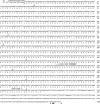Identification and classification of genes that act antagonistically to let-60 Ras signaling in Caenorhabditis elegans vulval development
- PMID: 16624904
- PMCID: PMC1526536
- DOI: 10.1534/genetics.106.056465
Identification and classification of genes that act antagonistically to let-60 Ras signaling in Caenorhabditis elegans vulval development
Abstract
The synthetic multivulva (synMuv) genes negatively regulate Ras-mediated vulval induction in the nematode Caenorhabditis elegans. The synMuv genes define three classes, A, B, and C, such that double mutants carrying mutations in genes of any two classes are multivulva. The class B synMuv genes include lin-35, a homolog of the retinoblastoma (Rb) tumor suppressor gene, as well as homologs of genes that function with Rb in transcriptional regulation. We screened for additional synMuv mutations using a strategy different from that of previous synMuv genetic screens. Some of the mutations we recovered affect new synMuv genes. We present criteria for assigning synMuv mutations into different genetic classes. We also describe the molecular characterization of the class B synMuv gene lin-65.
Figures


References
-
- Altschul, S. F., W. Gish, W. Miller, E. W. Myers and D. J. Lipman, 1990. Basic local alignment search tool. J. Mol. Biol. 215: 403–410. - PubMed
-
- Anderson, P., 1995. Mutagenesis, pp. 31–58 in Caenorhabditis elegans: Modern Biological Analysis of an Organism (Methods in Cell Biology, Vol. 48), edited by H. F. Epstein and D. C. Shakes. Academic Press, New York.
-
- Austin, J., and J. Kimble, 1989. Transcript analysis of glp-1 and lin-12, homologous genes required for cell interactions during development of C. elegans. Cell 58: 565–571. - PubMed
-
- Beitel, G. J., S. G. Clark and H. R. Horvitz, 1990. Caenorhabditis elegans ras gene let-60 acts as a switch in the pathway of vulval induction. Nature 348: 503–509. - PubMed
Publication types
MeSH terms
Substances
Associated data
- Actions
- Actions
Grants and funding
LinkOut - more resources
Full Text Sources
Other Literature Sources

